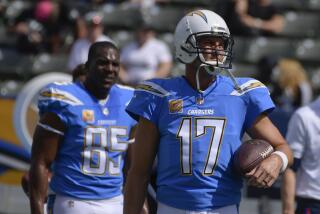Microsoft’s Gates Reigns as 300-Pound Gorilla of PCs : Computers: Admired and feared, the former Harvard technoid is always there when trends are set. His future depends on juggling his agenda against IBM’s.
- Share via
In an industry with no shortage of overnight millionaires and oversize egos, the compulsive and persistent chairman of Microsoft Corp. has managed always to be at center stage.
William H. Gates III was there in 1975, a Harvard University sophomore crafting a version of the programming language Basic as a chaotic band of technoids kicked off the personal computer revolution in Albuquerque, N.M. Gates was at the right place again in 1980, eager to oblige when International Business Machines Corp. went on a hunt for a partner to develop the underlying software--an operating system--for its first PC. And Gates was in the spotlight in Cupertino, Calif., in 1984, lined up before a throng of giddy enthusiasts to endorse Apple Computer Inc.’s new Macintosh computer.
Whenever trends are to be set, Gates is there, arguing arcane technical points or cutting shrewd business deals, always prodding, shoving and even whining--all to the end of added power and fatter fortunes for Microsoft.
Admired and feared, the 35-year-old Gates, perhaps more than any other single player, has put his stamp on an industry that in a decade’s time has transformed the way the world works and plays.
“I look at people who have had impact on the whole technology industry and his name is right at the top,” said Fred Gibbons, president of Software Publishing Corp. of Mountain View, Calif. “Microsoft is it in the ‘90s.”
Gates’s story is made for TV-almost. Were he not born into a family of ample financial means and prominent social standing, his ascendancy to industry power-broker would be a classic American success story.
As a teen, Gates earned the respect of fellow hackers for busting into corporate computer systems, and landed the job as a head page in the Senate. At 15, he founded a company with buddy Paul Allen to harness computers to track the Seattle area’s traffic patterns.
While at Harvard, 19-year-old Gates again teamed up with Allen, this time to pursue Allen’s fascination with the newly minted Altair computer, one of the first PCs. The pair pulled all-nighters to code Basic for the Altair without even seeing the machine. Miraculously, the software worked the first time Allen delivered it to Albuquerque, and it was an instant hit. Gates dropped out of college, and in 1975, the two launched Microsoft.
The suburban Seattle company has grown nonstop since. Today, it is the No. 1 seller of personal computer software, with sales of $1.2 billion in the last fiscal year. One of the few PC pioneers still entrenched in his own company, Gates has a paper net worth of $3 billion.
Despite his wealth and hard-nosed business style, Gates retains a certain boyish charm. He has the slightly disheveled look of a brainy adolescent, with tousled hair and oversize glasses that slide down his nose. Although his favorite work attire is open shirts and Dockers slacks, he also has a taste for some of the finer things: He’s building a new 30,000-square-foot hillside home overlooking Lake Washington and has on order a $600,000 limited-edition Porsche 959. Microsoft’s cash cow is the MS-DOS operating system, the software that’s been shipped with an estimated 40 million personal computers. Because of MS-DOS, not only IBM but also dozens of PC makers are beholden to Gates.
But the company’s influence doesn’t end there. Its products include languages and applications, such as word processors and spreadsheets. It produced one of the early PC games, Flight Simulator. It publishes books and is working to popularize optical discs as a means for storing huge volumes of information, like whole encyclopedia sets.
And its role is expanding. Microsoft has major efforts under way to develop software for linking computers, for recognizing handwriting and for creating so-called “multimedia” computer systems that will allow users to mix sounds, video, photo-quality graphics, speech and text.
To turn all the dreaming--or even part of it--into reality requires that Gates lure even more companies into his camp. That has not always been his strong suit. Sometimes rude and always opinionated, Gates can lose friends as easily as he makes them. Last year, he challenged Adobe Systems Inc., the dominant firm developing software that controls how printers draw typefaces. Earlier, Gates blasted the new computer unveiled by his one-time ally, Steve Jobs, reportedly calling its features “truly trivial.” And more recently, he angered a number of software companies by bringing out Microsoft’s latest software hit--Windows 3.0--to compete against similar software he had developed with IBM to make PCs easier to use.






